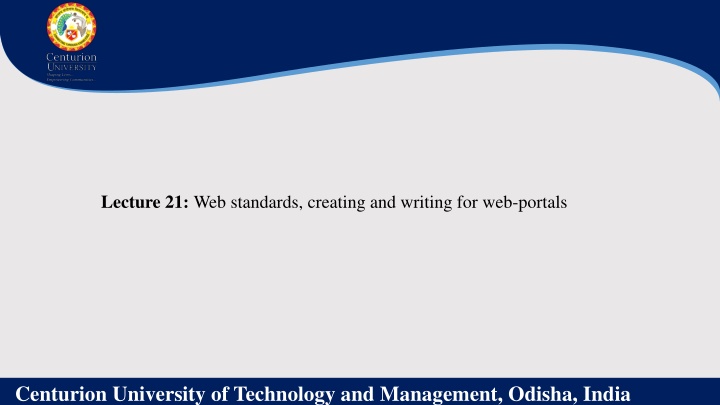Enhancing Web Presence for Agricultural Portals
Adhering to web standards is crucial in creating agriculture content for the web to ensure compatibility, accessibility, and usability. Utilize HTML for structuring, CSS for presentation, and ensure responsive design for various devices. Follow guidelines for accessibility, optimize performance, test for cross-browser compatibility, and focus on clear content creation for successful web portals.
Download Presentation

Please find below an Image/Link to download the presentation.
The content on the website is provided AS IS for your information and personal use only. It may not be sold, licensed, or shared on other websites without obtaining consent from the author.If you encounter any issues during the download, it is possible that the publisher has removed the file from their server.
You are allowed to download the files provided on this website for personal or commercial use, subject to the condition that they are used lawfully. All files are the property of their respective owners.
The content on the website is provided AS IS for your information and personal use only. It may not be sold, licensed, or shared on other websites without obtaining consent from the author.
E N D
Presentation Transcript
Lecture 21: Web standards, creating and writing for web-portals Centurion University of Technology and Management, Odisha, India
Web standards When creating agriculture content for the web, it's important to adhere to web standards to ensure compatibility, accessibility, and usability across different devices and platforms. Here are some key web standards to consider: 1.HTML (Hypertext Markup Language): Use the latest version of HTML (currently HTML5) to structure your web pages. HTML provides semantic tags that help search engines understand your content better. Properly structuring your content using headings, paragraphs, lists, and other HTML elements improves accessibility and readability. 2.CSS (Cascading Style Sheets): Use CSS to define the presentation and layout of your agriculture content. CSS allows you to control fonts, colors, spacing, and other visual aspects of your web pages. By separating content from presentation, CSS makes your content more flexible, easier to update, and consistent across different devices. 3.Responsive Design: Design your agriculture website to be responsive, which means it adapts and displays correctly on various devices and screen sizes. Use CSS media queries to adjust the layout, font sizes, and images based on the screen size. Centurion University of Technology and Management, Odisha, India
4.Accessibility (WCAG): Follow the Web Content Accessibility Guidelines (WCAG) to make your agriculture content accessible to people with disabilities. Ensure proper use of alternative text for images, provide captions for videos, use headings correctly, and ensure color contrast is sufficient. 5. Performance Optimization: Optimize your web pages for fast loading times. Compress images, minify CSS and JavaScript files, and leverage caching techniques to reduce page load times. Fast-loading pages improve user experience, reduce bounce rates, and are favored by search engines. 6.Cross-Browser Compatibility: Test your agriculture content across different web browsers (such as Chrome, Firefox, Safari, and Internet Explorer) to ensure consistent rendering and functionality. Validate your HTML and CSS code using tools like the W3C Markup Validation Service to catch any errors or issues. Centurion University of Technology and Management, Odisha, India
Creating and writing for web-portals 1.Define Your Goals: Determine the purpose and objectives of your agriculture web portal. Is it meant to provide information, offer services, connect farmers, or facilitate transactions? Understanding your goals will help shape the content and features of the portal. 2.Identify Your Target Audience: Define the target audience for your agriculture portal. Consider their needs, interests, and levels of expertise. This will help you tailor the content and user experience to meet their requirements. 3.Plan the Structure and Navigation: Create a logical and intuitive structure for your portal. Divide the content into sections or categories based on topics such as crops, livestock, market information, agricultural practices, or research. Develop a clear navigation menu that allows users to easily find the information they need. 4.Content Creation: Generate high-quality, relevant, and engaging content for each section of your portal. Consider including articles, guides, videos, infographics, case studies, and success stories. Centurion University of Technology and Management, Odisha, India
5.User-Generated Content: Encourage user-generated content to foster a sense of community and engagement. Allow farmers and stakeholders to share their experiences, insights, and tips through forums, discussion boards, or submission forms. This can enrich the portal with diverse perspectives and create a platform for knowledge sharing. 6.Visual Design: Create an appealing and professional design for your agriculture portal. Use a visually pleasing color scheme, choose appropriate fonts, and include relevant images and illustrations. Ensure that the design is responsive and adapts well to different screen sizes. 7.Interactive Features: Incorporate interactive features to enhance user engagement and functionality. This may include tools such as calculators, interactive maps, weather widgets, crop planners, or pest/disease identification tools. These features provide practical value to users and set your portal apart from static information sources. 8.Search Functionality: Implement a robust search functionality within your portal to help users quickly find specific information. Use relevant keywords, tags, and filters to improve search accuracy and provide a seamless user experience. Centurion University of Technology and Management, Odisha, India
9.Mobile-Friendly Optimization: Optimize your web portal for mobile devices. With the increasing use of smartphones and tablets in agriculture, it's essential to ensure that your portal is accessible and user-friendly on mobile platforms. 10.Testing and Feedback: Test your portal extensively across different devices, browsers, and operating systems to ensure compatibility and functionality. Gather feedback from users, farmers, and stakeholders to identify areas for improvement and implement necessary adjustments. 11.Regular Updates: Regularly update and maintain your agriculture web portal. Keep the content fresh, add new features, and address any issues or bugs that arise. This demonstrates your commitment to providing up-to- date and reliable information. Centurion University of Technology and Management, Odisha, India























